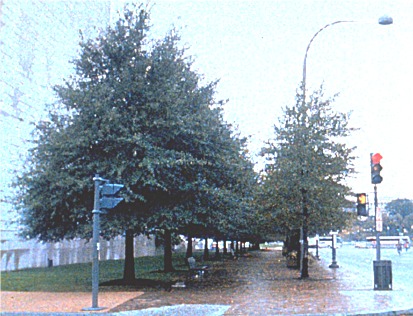

Case Studies |
||
- Olympic Plaza Case Study – Sydney, Australia - Rhizotron pilot study - University of Florida Experiments - List of Local Project with Structural Soils
Olympic Plaza Case Study – Sydney, Australia This project, consisting of the study of fig trees in an urban setting, was part of the Homebush Bay Master Concept Design vision developed by Hargreaves Associates in 1996. The project involved the installation of fig trees into an urban setting in Sydney Australia, incorporating the use off structural soils, and connections between constructed nature and functioning habitat. The Master Design Concept was composed of three stages, the ‘red move,’ ‘green move,’ and ‘blue move.’ The ‘red move’ consisted of the development of the plaza open space and the public forum. The ‘green move’ includes the plantings such as the central park, tree grove, urban forest, and plaza fig trees. The ‘blue move’ involves the water elements incorporated into the design. The plaza fig trees and their soil are the subjects of this study. The figs provide a shaded walk, in contrast to the open feeling of the plaza. The trees are watered by rain filtering through the plaza’s eco-paving, “providing air and moisture to the root zone of the plaza figs. Excess water is collected and diverted to…wetlands…linking into the site-wide water management system.” Once it was decided that the trees were functionally and visually adequate, the transplant project began. More than 20 trees had been transplanted and were fully mature upon time of installation. To maximize the longevity of the plaza figs, structural soil techniques were tested. Part of the problem with trees in an urban setting is that the soil volume is not large enough. In the case of Olympic plaza, increasing soil volume wasn’t an option. Using research from UC Davis and Cornell University, a soil mix was developed as a pavement sub-base and tree growth aid. This mix “consists of rocks of a single grading (40mm). These rocks bear on one another, providing the structural stability for the pavement above. As they bear, voids are created-this is where the soil mix resides. The aim is to fill each void by 50-70%, minimizing ‘cushioning’ of soil between rocks, whilst providing space for air and future root expansion.” This mix was used to provide a resource beyond the tree pit, not as a replacement for tree pit soil. Through lab trials and field tests several structural mixes were evaluated to adjust for climatic and tree species differences.
Rhizotron pilot study This study contrasted three types of street tree installation techniques. These included conventional sidewalk tree planting methods, a method using structural soil material, and a control installation technique to measure of root growth and nutrient levels. Although this study was conducted in a regulated lab setting to minimize confounding variables, the conditions created were meant to mimic an average sidewalk. In the two test cases, the grade was compacted to sidewalk load-bearing capacity specifications. To measure the success of the three methods, a viewing chamber, called a ‘rhizotron,’ was installed alongside the length of the roots. Pre-existing rhizotrons at Cornell University were used. The first soil profile was typical of compacted New York state sidewalk material. The structural soil profile (second profile) consisted of 80% gravel, 20% clay loam, and .025% polyacrylamide stabilizing hydrogel, and was compacted to meet sidewalk load bearing requirements. The third profile, the control, was not compacted because it was supposed to resemble agricultural, or non-urban conditions. Three different kinds of trees (Acer campestre, Tilia cordata, and malus spp. ‘Adorondack’) were selected to assess a reaction to the different conditions over a variety of species. The trees were spaced uniformly in the test plot, and watered each day during the week before pavement was laid. Samples were taken weekly to measure longer term patterns. Hourly samples were taken as well to measure day/night temperature fluctuations. Oxygen and moisture content, root length, and density were measured at different depths to determine the overall root health, but by the time of publishing of the Rhizotron Pilot Study, the final measurements had not been taken. Above ground evaluations of tree health were taken as well, by measuring leaf growth, chlorophyll and nutrient content. As expected, the roots of the trees planted in the structural soil material grew deeper, and were healthier than those planted in conventional sidewalk tree pit fashion. The oxygen level in roots growing beyond two feet deep into the ground dropped to below 5% in the standard, compacted soil. This is bad. It is difficult to draw concrete conclusions from this study due to the newness of the subject, lack of available information and studies for cross-reference, and low number of test subjects. However, this study does support current hypotheses of the benefits of using a structured sub-base material to increase root and tree health, and ultimately the longevity of a streetscape.
University of Florida Experiments University of Florida is documenting the longer term results of tree growth in structural soil compared to other types of soils in the same climate conditions.
List of Local Projects with Structural Soils University Avenue, Seattle WA, City of Seattle - The sidewalk used one type of structural soil that is same in concept as CU structural soil, but without the high supportive capability for car traffic.
CU-Soil projects Seattle Central Library, Seattle, WA Pearl Jones Development, Covington, WA West Seattle High School, Seattle, WA University of Washington Projects, Seattle, WA US Courthouse, Seattle, WA Bon Marche, Redmond, WA |
||
|
||

